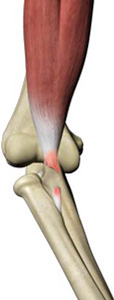
Biceps Tendon Injuries Specialist
Even though the biceps is a strong muscle in the front of the arm, it can still be susceptible to tears and injuries, usually stemming from an elbow or shoulder injury. The biceps muscle is located in the front of the arm and is held in place by durable biceps tendons in the shoulder and at the elbow. These tendons adhere the muscle to the bones in the shoulder and the elbow.

Biceps Tendon Injuries - SLAP Tears - Shoulder Tendinitis (Dallas, TX)
About Biceps Tendon Injuries
Even though the biceps is a strong muscle in the front of the arm, it can still be susceptible to tears and injuries, usually stemming from an elbow or shoulder injury. The biceps muscle is located in the front of the arm and is held in place by durable biceps tendons in the shoulder and at the elbow. These tendons adhere the muscle to the bones in the shoulder and the elbow. Therefore, if there’s any type of disruption to these tendons as a result of wear and tear, a sports injury, or a fall, the result could be a tendon injury which can be painful and limit mobility. A tear can be partial where the tendon isn’t completely severed or it can occur at the shoulder (proximal tears) or elbow (distal tears).
Injury Symptoms
While there are various types of biceps tendon injuries, there are certain symptoms that can be found across the board. Commonly, there is a sudden, sharp pain in the elbow or upper arm. In some cases, a patient may hear or feel a “pop”, which signals that the tendon is torn. Experiencing weakness in the shoulder or elbow, having problems rotating the arm (for example, not being able to place the arm palm up or palm down), a noticeable bruise on the upper arm, and changes in the contour of the arm are other common symptoms. For some patients, a bulge may develop in the arm since the biceps isn’t being held in place properly by the tendons.
Types of Biceps Injuries
There are several types of biceps tendon injuries and these include:
- Biceps Tendinitis – This stems from overusing the tendons, especially due to repetitive motion and is commonly seen in athletes such as tennis players, baseball players, and swimmers. It can also result from any number of serious injuries to the tendon. Tendonitis can cause a patient to feel sore and experience pain in the anterior shoulder that can radiate down the arm towards the elbow.
- SLAP (Superior Labrum Anterior and Posterior) Tears – This is an injury to the labrum, the ring of cartilage that surrounds the shoulder joint’s socket. The labrum plays a role as an attachment point for one of the biceps muscle’s tendons. A SLAP injury results when the top part of the labrum is injured in the area where the biceps tendon connects to the labrum. The injury can be caused by falling on the arm, shoulder dislocation, or when trying to catch a heavy object.
- Biceps Tendon Instability – Also known as subluxation, this condition affects the “long head” of the biceps tendon as it exits the shoulder, which is the tendon that attaches at the shoulder and runs along the bone’s groove before entering the shoulder joint. Since the groove is encompassed by ligaments to keep the biceps in place, injury to these ligaments cause the tendon to move in and out of this groove resulting in biceps tendon instability. It can be commonly caused by a rotator cuff tear that’s either degenerative or traumatic in nature.
- Proximal Biceps Tendon Rupture – With a proximal rupture, the injury occurs to the tendon where it attaches to the top of the socket in the shoulder joint. The tendon makes a sharp turn to exit the shoulder joint and is highly susceptible to injury. This type of rupture is usually associated with rotator cuff tears. This condition is common among patients 60 years or older and can sometimes result in few symptoms and the tear actually heals on its own. In severe cases, there are can be deformity or bulge in the lower arm known as a “Popeye sign.”
- Distal Biceps Tendon Rupture – This rupture happens at the elbow joint and is commonly found among middle-aged men who participate in sports or engage in heavy lifting. This rupture is usually accompanied by a large popping sound. This type of injury usually requires surgery to repair the tendon in order to recover full elbow and forearm strength and function.
Treatment Options
There are several surgical and nonsurgical options to treat the various types of biceps tendon injuries.
Nonsurgical options are:
- Resting the arm, including avoiding strenuous activity like heavy lifting or weight training
- Applying cold packs and ice to reduce swelling and alleviate pain
- Taking nonsteroidal anti-inflammatory medications for pain
- Physical therapy to restore mobility and regain strength
Surgical options include:
- Arthroscopic or open surgery to reconnect the torn tendon back to the bone in the shoulder
- For shoulder injuries, the long head of the biceps is reconnected with a screw or suture anchor. This procedure utilizes an incision in the front of the shoulder to anchor the biceps tendon to the upper part of the arm bone.
- For elbow injuries, the procedure involves making a small incision to re-attach the torn tendon to the forearm bone. This is typically done using suture anchors or an interference screw.
Repair Your Arm
Regardless of what type of biceps tendon injury you have or how it occurred, our orthopedic office is here to help your arm heal properly. We will X-ray your arm to determine the origin of the injury and its severity. From there, our team of experts can determine the best course of treatment to get the best results. Not only do we want to make pain go away, but we want you to regain the arm strength to get back to daily life and all the activities that you love. We encourage you to give our office a call to schedule your appointment as soon as possible.
*Individual results are not guaranteed and may vary from person to person. Images may contain models.




